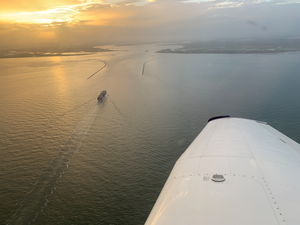Charleston Harbor

The Charleston Harbor is an
Sullivan's Islands shelter the entrance. Charleston Harbor forms part of the Intracoastal Waterway.[1]
History

Charleston Harbor was a major port of entry for
slave ships
transporting slaves from West Africa. Due to its status as a slave capital,
“Scholars estimate that over forty percent of all enslaved Africans sent to North America entered through Charleston Harbor — making Charleston the largest North American point of disembarkation for the trans-Atlantic slave trade.”[2]
The harbor contains

The 12-foot natural depth of the harbor was a major reason for the establishment and growth of Charleston. The Rivers and Harbors Act of 1852 authorized the federal government to dredge the channels of the harbor to a depth of 17 feet. This deepening work was interrupted by the Civil War and was not completed until after the war's end.[4] The jetties at the entrance to the harbor were constructed between 1878 and 1886.[5]
Transportation
The harbor includes public terminals owned and operated by the
U.S. Army Corps of Engineers began to design a deepening of the channels to 52 feet.[6][7] The harbor deepening project was spurred on by the Panama Canal's recent expansion in an effort to handle the larger ships traveling from Panama without facing restrictions listed above.[8] As of May 2017, the project will cost around $500 million, with $317.5 million federally allocated.[9][10] Port officials plan to make the Charleston Harbor the deepest harbor on the East Coast by the end of the decade.[11]
[12]
See also
- Charleston, South Carolina in the American Civil War
- Waterways forming and crossings of the Atlantic Intracoastal Waterway
References
- ^ Charleston Harbor[permanent dead link]. Columbia University Press at Bartleby.com. Accessed 2 November 2006.
- ^ Battle, Mary (2013). "Establishing Slavery in the Lowcountry". LDHI. College of Charleston. Retrieved May 1, 2023.
- ^ U.S. Navy history website Archived October 14, 2007, at the Wayback Machine
- ^ U.S. Army Corps of Engineers, Charleston Harbor Post 45: Final Integrated Feasibility Report and Environmental Impact Statement, Page 1-6.
- ^ Sargent, Francis E. Case Histories of Corps Breakwater and Jetty Structures, Department of the Army, Vicksburg Mississippi. September 1988. Page 34. Accessed September 25, 2015.
- ^ Landers, Jay (September 2015). "Corps to Begin Design Phase of Charleston Harbor Deepening Project". Civil Engineering. 85 (9). Reston, Virginia: American Society of Civil Engineers: 24–26.
- ^ "Charleston Harbor deepening project allocated $17.5M in federal funding". Retrieved 2017-09-14.
- ^ "Charleston Harbor deepening project allocated $17.5M in federal funding". Retrieved 2017-09-14.
- ^ "Charleston Harbor deepening project allocated $17.5M in federal funding". Retrieved 2017-09-14.
- ^ "www.scspa.com/news/charleston-harbor-deepening-project-receives-construction-funding/". www.scspa.com. Retrieved 2017-09-14.
- ^ "Charleston Harbor deepening project allocated $17.5M in federal funding". Retrieved 2017-09-14.
- ^ "Charleston port on its way to East Coast's deepest harbor with federal dollars in hand".
External links
- Charleston Harbor Post 45, Official project website
- South Carolina State Ports Authority
